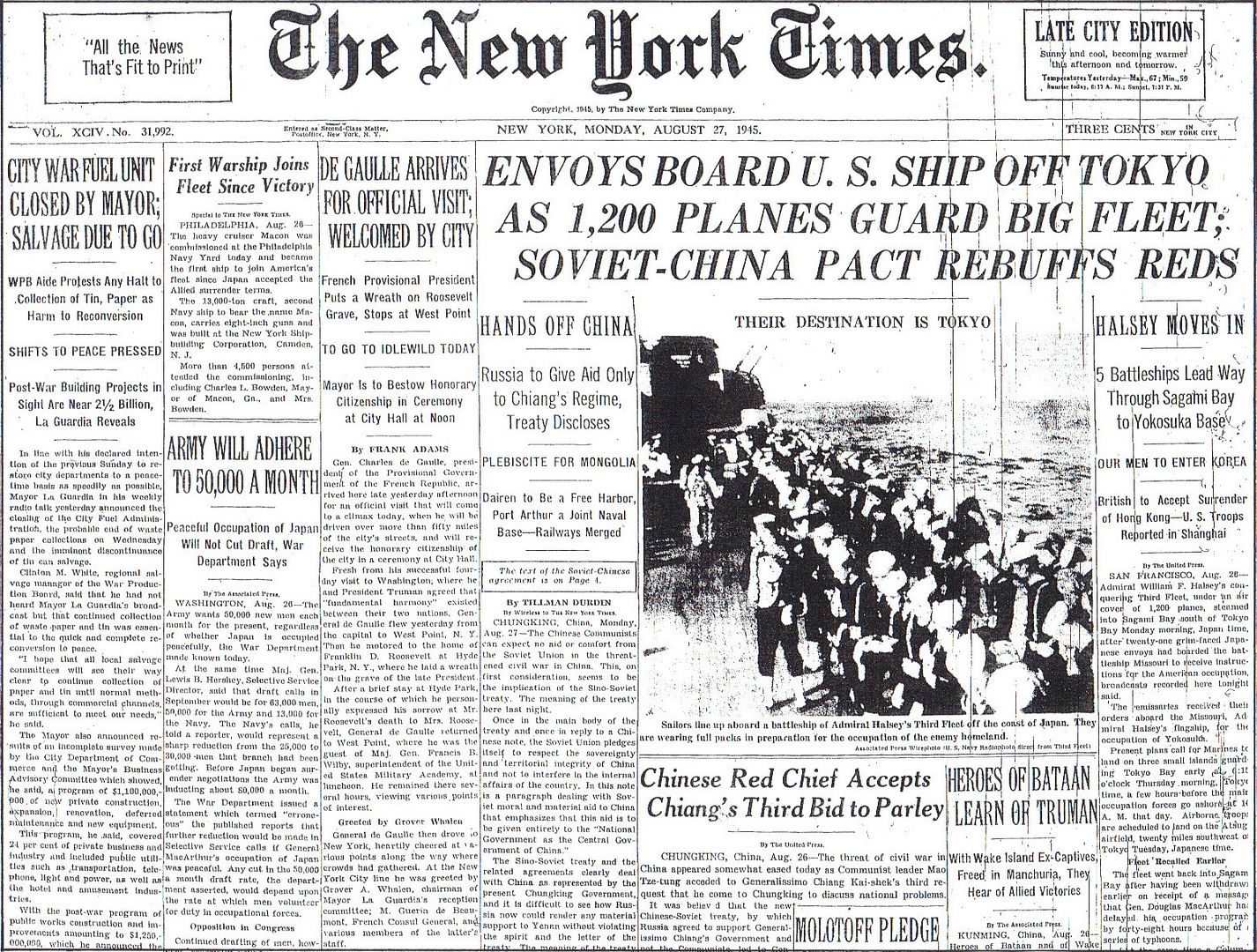
Posted on 08/27/2015 4:56:35 AM PDT by Homer_J_Simpson

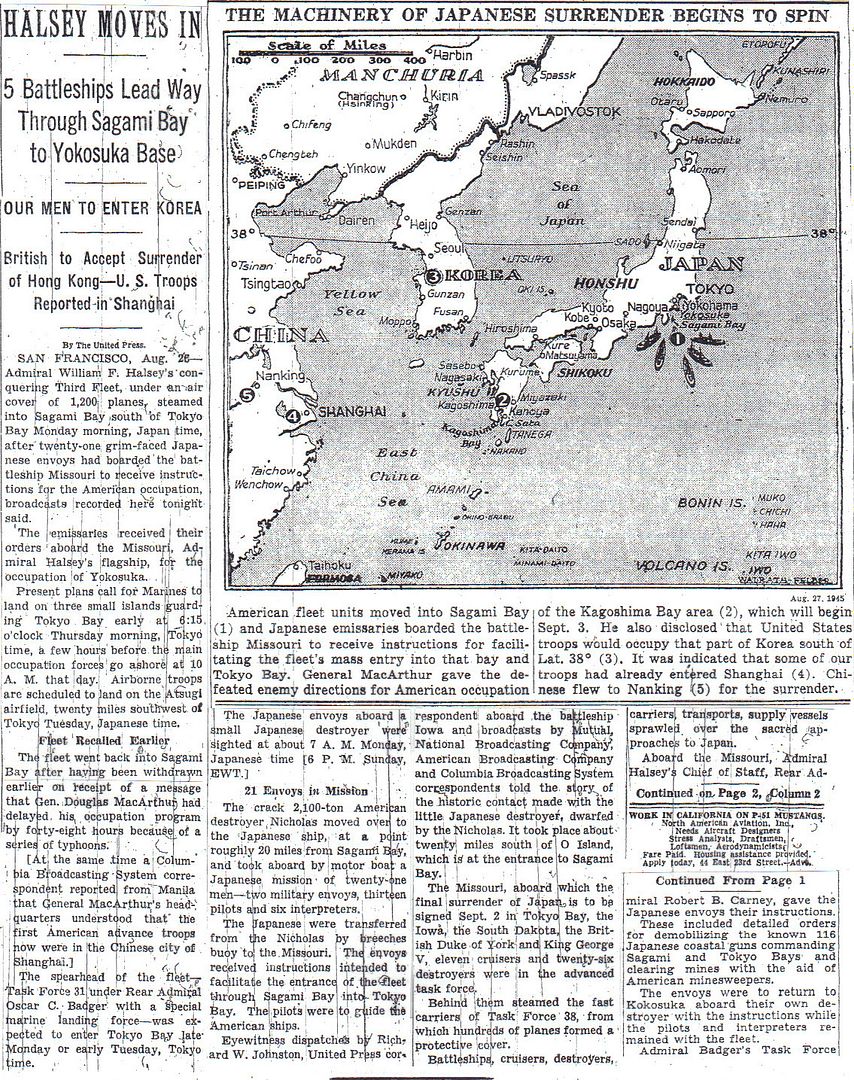
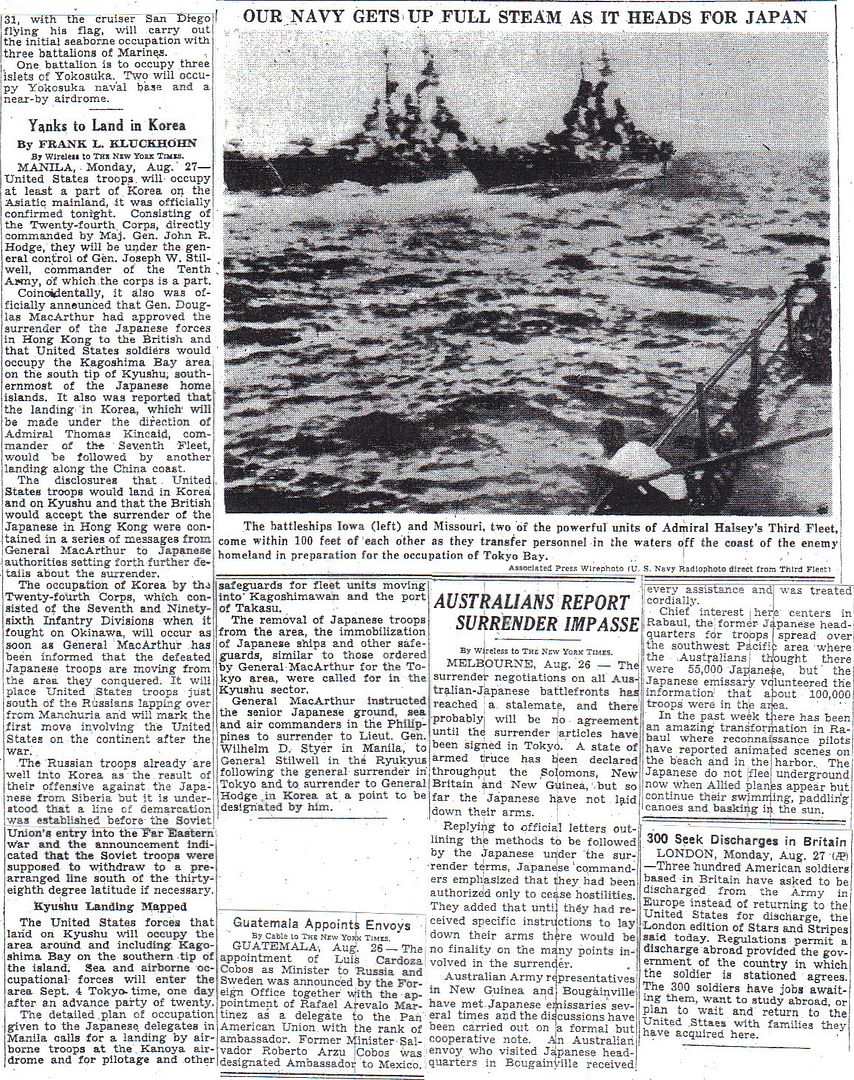
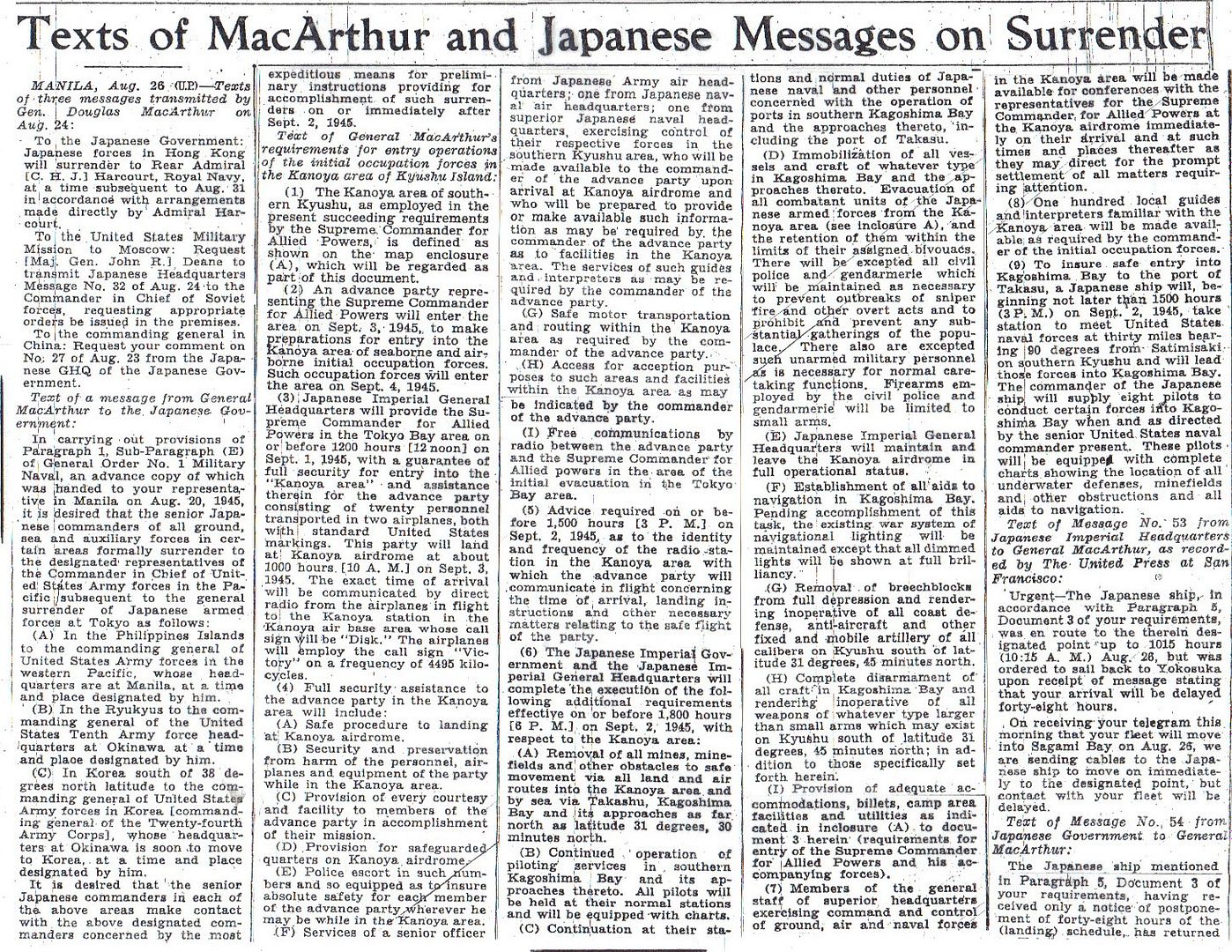
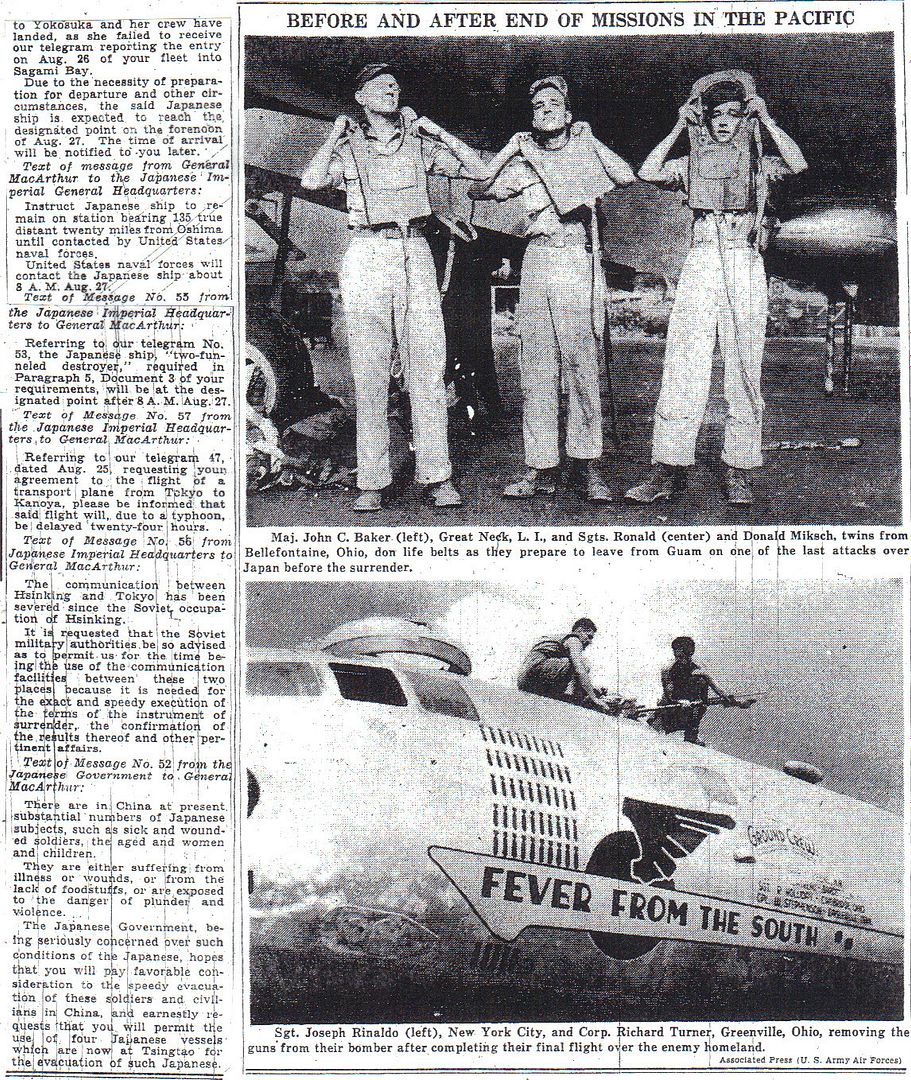

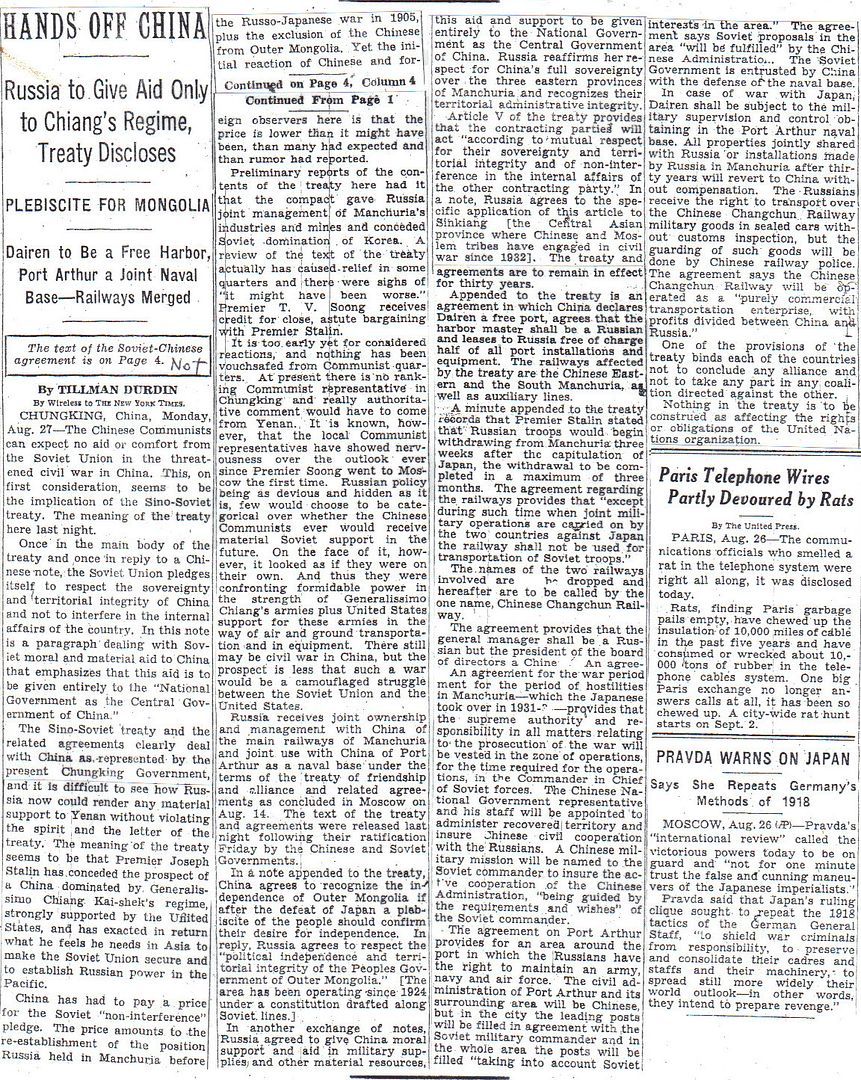
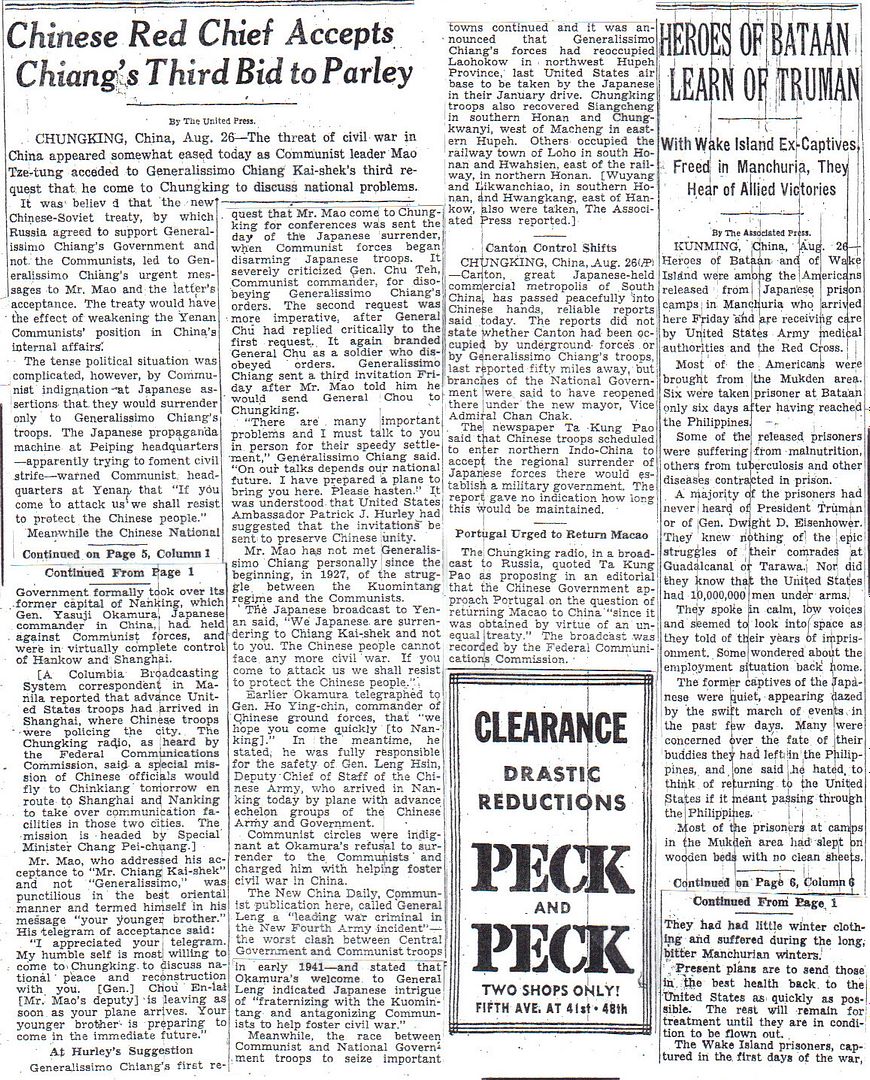
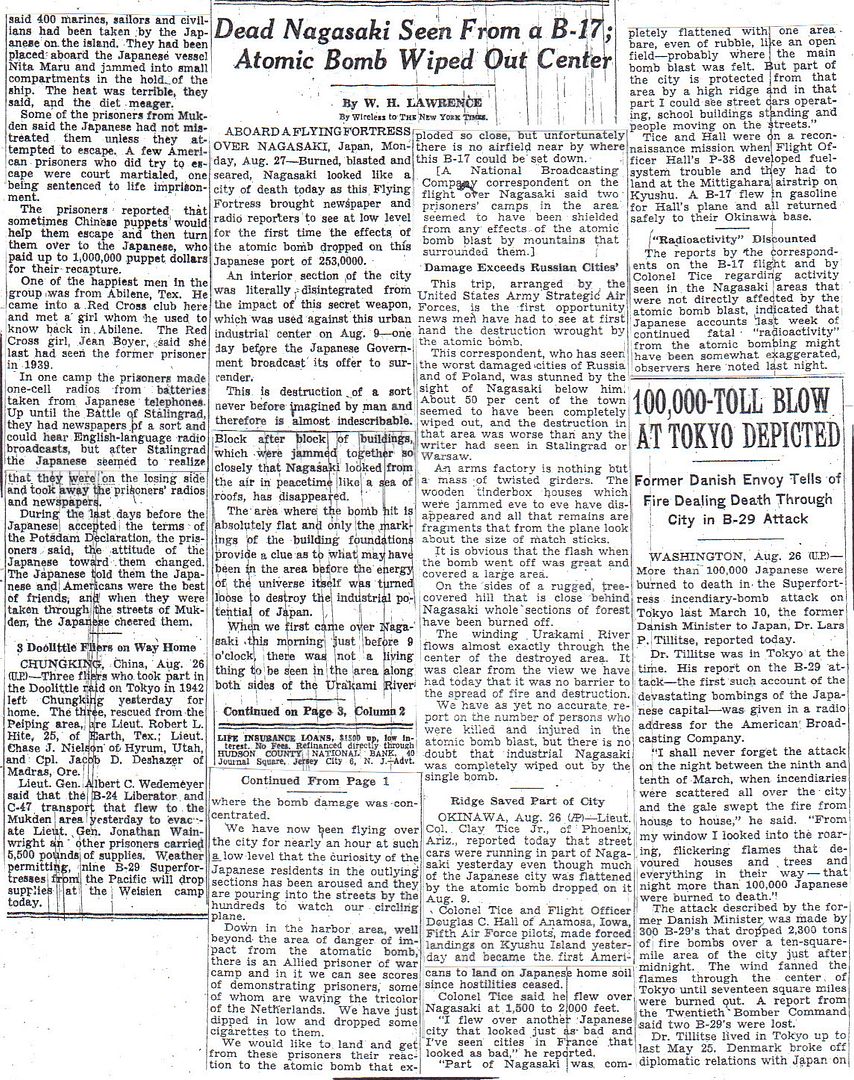

http://www.etherit.co.uk/month/7/27.htm
August 27th, 1945 (MONDAY)
UNITED KINGDOM: 542 Squadron, RAF, (Photo Reconnaissance) is disbanded at RAF Benson. (Bob Hart)(137)
BURMA: Contact has been established with the Japanese troops in the Sittang valley and they now await specific surrender instructions.
JAPAN: The US Twentieth Air Force B-29 Superfortresses begin supplying prisoners-of-war and internee camps in Japan, China, and Korea with medical supplies, food, and clothing. The first supply drop (to Weihsien Camp near Peking, China) is followed by a concentrated effort of 900 sorties in a period of less than a month. 4,470 tons of supplies are dropped to about 63,500 prisoners in 154 camps.
A USN PB4Y-2 Privateer lands at Atsugi Airfield, Japan because of mechanical problems. The Japanese do not approach the aircraft and the plane returns to Iwo Jima the same day.
Halsey moves his fleet into Sagami Bay, southwest of Yokohama. At 6:00 AM the 4th Marines land to begin dealing with harbour defences.
With most surrender and occupation arrangements made, the Allied fleet prepares to enter Sagami Wan (Bay) and the adjacent Tokyo Bay. To facilitate this operation, the Japanese destroyer HIJMS Hatsukakura brings out several Japanese naval officers to provide piloting services. Fear of treachery remained strong, so the visitors are carefully searched and treated sternly. However, there are no hostile incidents, and the pilots safely bring the U.S. and British warships into their anchorages. Part of this armada is the USN’s Third Fleet under Admiral William F. Halsey Jr. The Third Fleet consists of 23 aircraft carriers, 12 battleships, 26 cruisers, 116 destroyers and destroyer escorts and 12 submarines.
BISMARCK ARCHIPELAGO: An armed truce has been declared throughout New Britain Island.
SOLOMON ISLANDS: Isolated Japanese garrisons are reported to be ignorant of the ceasefire.
U.S.A.: President Harry S. Truman says that the situation in the Pacific continues to have many elements of danger and urges Congress to continue the draft (conscription) for a further two years.
bookmark
Britain to receive 1,000s of LST from Pacific. Looks like it was only 113? but that may have been during the war. A very good history of LST at site.
A total of 1,152 LST’s were contracted for in the great naval building program of World War II, but 101 were cancelled in the fall of 1942 because of shifting construction priorities. 0f 1,051 actually constructed, 113 LST’s were transferred to Great Britain under the terms of lend-lease, and four more were turned over to the Greek Navy. Conversions to other ship types with different hull designations accounted for 116.
The end of World War II left the Navy with a huge inventory of amphibious ships. Hundreds of these were scrapped or sunk, and most of the remaining ships were put in “mothballs” to be preserved for the future. Consequently, construction of LST’s in the immediate post-war years was modest.
More discussion here. A versatile ship. used for ferrying after the war.
http://military.wikia.com/wiki/Landing_Ship,_Tank
Here is a list of LST, many returned to US in 46 and 47 per lend lease rules, (but scrapped)
http://www.warshipsww2.eu/lode.php?language=E&period=&idtrida=1051
B29s Drop Supplies. Note the number of planes and crewmen lost hin this operation. It was a long process. Worth reading.
http://user.xmission.com/~tmathews/b29/56years/56years-4508b.html
27 August 1945 (pg 702)
MARIANAS:
XX AF B-29’s begin supplying prisoner-of-war and internee camps in Japan, China, and Korea with medical supplies, food, and clothing. The first supply drop (to Weihsien Camp near Peking, China) is followed by a concentrated effort of 900 sorties in a period of less than a month. 4,470 tons of supplies are dropped to about 63,500 prisoners in 154 camps through the end of September. (Eight B-29’s were lost along with 77 crewmen during this operation. In addition, one B-29 was attacked by Soviet fighters while flying over North Korea and was forced to land).
(This message exchange tells a lot about the POW missions:)
A message from Jack Blevins on 16 May 2000 to the e-mail list:
“My crew flew on two of these. The only one of these that I can remember was the one in which the wooden crates or pallets and the packages were wrapped and placed on in the bomb bays. The wooden pallets ... were attached to parachutes. The prisoners painted POW on top of their barracks and that was our aiming point. The reason I remember this mission was that one of the wooden pallets we released crashed thru the roof of one of the P.O.W. barracks. As far as I remember we never knew what all was in the packages.”
Jack Blevins
A response from Bob Goldsworthy:
“I can tell you what was part of the delivery (POW drop) that went through the barracks roof. Especially if the drop was over Omori POW Camp. It was Cashmere Bouquet soap. At least a case of it crashed through the roof of my barracks about three feet from my head.
“I thought, what a hell of a thing to live through prison life only to get killed by a case of soap. But the food that was dropped saved lives.”
Bob Goldsworthy
The same article says that the Marines will inhabit "three islets of Yokosuka." I only know of one island near the base, Sarushima (Monkey Island); a CNN Travel article about it is here. There are two artificial islands on the Chiba side of the bay that were built in the 1800s for protecting the entrance to Tokyo Bay, and that may be what the article is referring to.
Also, the "airdrome" would have been on Natsushima (Summer Island), which is technically an island, though it is connected to the mainland by short causeways. Natsushima is just north of the Yokosuka naval base and east of Oppama, though I don't remember an airfield ever being there; the page here says it was used until the 1950s. The airfield seems to have had its own patch, however, here.
Photo. Removing guns from bombers after final mission.
Heros of Bataan
The prisoners reported that sometimes Chinese puppets would help them escape and then turn them over to the Japanese, who paid up to 1,000,000 puppet dollars for their recapture.
Sounds like “Big Island” is the Japanese equivalent of “Deer Creek” in the United States.
Interesting that Pravda believes that the cessation of hostilities with Japan had a lot in common with the Armistice of 1918.
Or Springfield, for that matter...
Japanese place names are generally, well, less than creative. Since we're sitting in Sagami Bay today waiting to enter Tokyo Bay, let's look at some of the place names on the Miura peninsula on which Yokosuka sits.
We begin with the town of Miura 三浦 for which the peninsula is named. The name means "three beaches," because, being at the southern end of the peninsula, it has, well, three beaches.
Going up the west side, we encounter Nagai 長井 or "head [water] well," and then Hayama 葉山 or "leaf mountain," whose two sections are Shimoyamaguchi 下山口 or "lower mountain entrance" and Isshiki 一色 or "one color."
Next stop is Zushi, which today is written 逗子 but was originally 豆師, though neither combination makes any sense: the word "zushi" is simply an antiquated way of saying "street."
Next we come to Kamakura 鎌倉, the first town for which the name has an interesting origin: "kama" 鎌 means sickle but the word "kama" can also mean a cooking pot 竃, and "kura" 倉 means "granary" (in the west it would be a silo, but they look different in ancient Japan). Both the cooking pot and the granary open in one spot and are closed elsewhere, just like Kamakura which is open to the sea but surrounded by mountains on the other three sides. Also, changing 竃 to 鎌 might have a connection to the militaristic government that ruled Japan from Kamakura in the middle ages, because a sickle was also a weapon, particularly the kind that would have been used by infantry at the time.
And at no extra charge...
Yokohama means "side harbor." Kyoto means "capital capital" (meaning "really the capital"), and Tokyo means "east capital". Hiroshima means "wide island." Osaka means "big hill." And the beat goes on...
My guess is that the guns would have to be removed after every mission, for maintenance purposes.
Guns taken off can be put back on.
Is it fair to say that the Japanese place name is in some way a physical description of the place itself? I know that in the Old World, place names tended to be that way but not to the same extent, and often the meaning of the place name was in an ancient language now in disuse. It appears very few place names in the United States are descriptive of the place.
Although, many U.S. locations retain Indian place names, which if I’m not mistaken are quite descriptive of the locale. Like the Japanese?
Omaha: “town (People) of the large canoes.”
Milwaukee: from an Algonquian word Millioke, meaning “Good”, “Beautiful” and “Pleasant Land”
Iowa: probably from an Indian word meaning “this is the place” or “the Beautiful Land.”
Poughkeepsie: The name derives from a word in the Wappinger language, roughly U-puku-ipi-sing, meaning “the reed-covered lodge by the little-water place,”
Etc.
List of place names of Native American origin in New York
https://en.wikipedia.org/wiki/List_of_place_names_of_Native_American_origin_in_New_York

Wayne Campbell: So, do you come to Milwaukee often?
Alice Cooper: Well, I'm a regular visitor here, but Milwaukee has certainly had its share of visitors. The French missionaries and explorers were coming here as early as the late 1600s to trade with the Native Americans.
Pete: In fact, isn't "Milwaukee" an Indian name?
Alice Cooper: Yes, Pete, it is. Actually, it's pronounced "mill-e-wah-que" which is Algonquin for "the good land."
Wayne Campbell: I was not aware of that.
Disclaimer: Opinions posted on Free Republic are those of the individual posters and do not necessarily represent the opinion of Free Republic or its management. All materials posted herein are protected by copyright law and the exemption for fair use of copyrighted works.